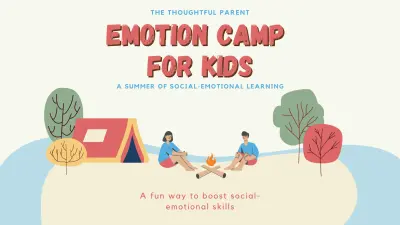Sneak peek: Do you struggle with childhood independence? Does it feel scary to let your child or teen do things on their own? A deep dive into why independence matters for child development.
When it comes to our children and teens, when do we let go and when do we hold tight? When do we give a little push and when do we let them hold back? How much independence do we encourage in our kids, and how much do we protect them? These are all questions of childhood independence that come to mind regularly as parents.
These questions start early, as soon as your child turns about two and starts making those first strides for independence by saying things like, “Me do it!”
These questions really take center stage as our children reach adolescence and the big teen milestones. Our oldest son is getting his driver’s license soon, so these types of questions are definitely top of mind in our house.

The risk of overprotection
Our instinct is to protect our children at all costs. We know there are risks all around—car accidents, injuries, etc. But what we may not often realize is that overprotecting them poses an almost equally hazardous proposition. Without letting them go and do the things they need to do to gain independence, we risk smothering their growth.
Some would argue that, in our parenting culture today, many parents have erred on the side of overprotection, and there does seem to be some data to support that. We know there’s been a decline in childhood independence—things like letting kids run around the neighborhood with friends or free play. There are also lower rates of teens getting driver’s licenses and summer jobs—things like that that used to be rites of passage. A recent study that came out from Mott’s Children’s Hospital showed that only 21% of parents would let their teenager go around an amusement park or museum on their own.
So the big question is this: how do you know what’s right for your child or teen? Instead of making broad claims like some “parenting experts” do about what’s right for your child, I think it’s better to think about the issue in terms of guidelines to consider (for children and teens of all ages):
Guidelines for childhood independence
Avoid comparing your child to others – even peers their same age.
In all things related to child development, there are a lot of temperamental differences. Some children (like mine) seem like they were almost born ready to be independent. It seems like from the moment they learn to walk, they want to go explore to see how far they can test the limits of their parents’ boundaries.
Other kids are less eager to be independent. They need a little encouragement to take strides towards independence.
There’s nothing wrong with either approach. You know your child best. If you feel like their reticence to do things on their own is holding them back from having important experiences, then they might need a little push. If not, then just wait and see what happens—they may be ready for a certain independent skill six months after their peers, or a year after. Observe and try to understand where they’re coming from.
Even within my own circle of friends, there was a big range in when our children were ready for different types of independence. Some teens I know were so eager to get their driver’s permit at 15 that they couldn’t even contain themselves. They wanted to go immediately to take the class and be able to drive with their parents. Other teens I know were terrified of the thought of it at 15, but a year or two later, they were more than ready. Does that make them slow or less mature? No, it tells you that they know themselves.

Allow your child to lead (within reason).
Of course, children can’t be in control of all these decisions, but what I have seen is that many times they will let you know when they’re ready for the next stage of independence. When my oldest son was about eight or so, he wanted to start hanging out with friends without me at the park across the street. I was nervous about it, but I knew his personality. I knew he wanted to have that feeling of confidence and independence to hang out with his friends. We allowed it in certain circumstances—at first, he had a walkie-talkie with him so he could communicate with us.
Overall, it ended up being a huge success. He made new friends, introduced us to their parents, and we all became friends. It was a great benefit for all of us. He knew he was ready for that. If you observe closely and tune into your child, you may see when they’re ready for a new step of independence.
Know the facts.
From the 1980s onward, we’ve had a media portrayal of things like child abductions and kidnappings that makes it seem like these are common and could happen at any time. When you really look at the statistics, it’s not the case. We know that child abductions by a stranger are exceedingly rare. You also have to know your area—know the statistics for your city or your county, and know the dangers. But overall, these types of dangers are very rare. Encouraging physical independence in the sense of letting children bike to a neighbor’s house or walk to school can be very important for helping them feel confident in their abilities. Understand your community so that you don’t feel overtaken by a fear that may not be based in fact.
If you need support in understanding what is fact and what is myth about child safety, I highly recommend the organization Let Grow, especially this facts page.
Encourage the gradual transfer of responsibility.
I picked up this phrasing from Montessori teachings, but it rings true for children of all ages. In the Montessori philosophy, the emphasis is mostly on skills like household chores and self-care tasks. Children gradually learn how to take more and more responsibility for certain things related to their own care and independence—washing hands, getting dressed, cleaning, etc. I think the same concept applies to these bigger milestones of independence, too, like walking alone to a friend’s house or driving. It doesn’t happen all at once. You have to gradually build your child’s independence, just like you would any other skill.
As your child or teen reaches certain ages, consider if there are things that they might be able to do on their own—whether it be in your home, outside your home, This approach help them build little bits of confidence along the way, so that when they turn 15 or 16 and want to go out with friends, it’s not this huge shock for either one of you.
With this approach, you’ve gradually been allowing them more and more independence. This also allows you and them to build trust in their skills. If you give them a little bit of childhood independence and something doesn’t turn out well— like they make a poor choice—then maybe you go back a step and re-establish earlier boundaries. This idea of gradual transfer of responsibility is key because it really helps you see their growth.
Here’s a fun example of this concept in a recent Instagram clip from one of my favorites, the Holderness Family:
Listen to the full episode too. Their guest, Dr. Lisa Damour, is excellent!
At all stages of parenting, this question of independence versus holding tight continues to come up. If you’re struggling with this, know that you’re not alone in feeling that it’s scary. It can feel scary to let your child do things on their own. If you can be intentional and mindful about it, this process can be a real transition of growth for you and your child. It can really help them build confidence and feel ready to enter the adult world when it’s their time.


Leave a Reply